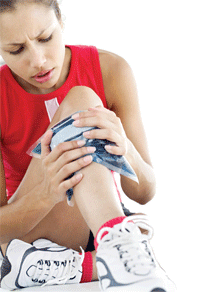 The most common complaint among exercisers is knee pain, especially during squats and lunges. If you suffer from knee pain, it may be easy to write these exercises off, but more often than not, the pain you experience may have more to do with your form than your joints themselves.
The most common complaint among exercisers is knee pain, especially during squats and lunges. If you suffer from knee pain, it may be easy to write these exercises off, but more often than not, the pain you experience may have more to do with your form than your joints themselves.
Squats and lunges do put a lot of pressure on your knees, which can cause a sharp pain right in the center of your kneecap. If your knees are sore during or after performing these exercises, a simple adjustment of your form may do the trick.
They seem simple: just bend your knees, right? Not quite. Where you place your weight during these exercises can mean all the difference. Proper form for squats and lunges will not only eliminate most knee pain, it makes the exercises more effective.
When performing squats and lunges, start with feet shoulder-width apart. You always want to keep your weight on your heels, which will engage the muscles in the back of the legs, targeting the hamstrings and glutes. You want to overload the muscles, not the joints, so when you lower down, in both squats and lunges, make sure your knees never pass over your toes.
When returning to the starting position, drive through your heels to keep the muscles engaged and joints out of the equation. If you struggle with this, you can even pull your toes up off the ground to ensure you aren’t putting weight on the ball of your foot.
Walking lunges can be one of the hardest exercises to keep proper form. Your chest should stay up at all times, with no bend in your waist, trying to get your knees to 90-degree angles. Most people walk in a forward motion, which puts a lot of pressure on the front leg, and thus, the knee. The correct motion your body should travel during the lunge, however, is straight up and down. The only time you move forward is when you switch your legs. Instead of thinking of walking forward, think more of a down, up, step forward, down, up, pattern.
Common form mistakes that can cause knee pain include:
- Letting your knee pass over your toe
- Keeping your weight on the ball of your foot
- Moving in a forward motion, placing more pressure on the knee, instead of straight up and down
- Using momentum, instead of isolating muscles to get you through the exercise
If you feel your form is right, and you still experience knee pain, ice and rest your knees. If you still suffer, you may need to see a doctor or wear a brace to protect yourself against injury.
